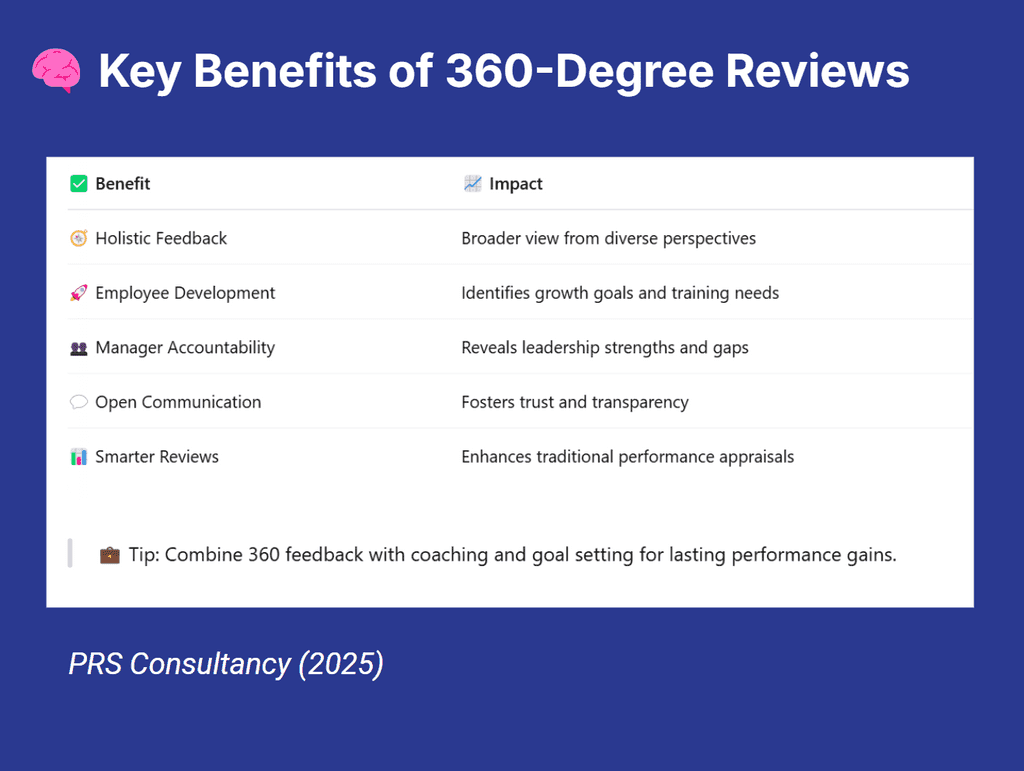A 360-degree review, also known as 360-degree feedback or appraisal, is a performance evaluation method that collects input from an employee's manager, peers, direct reports, and sometimes clients. Unlike traditional top-down reviews, 360-degree evaluations provide a comprehensive perspective that supports fairer, more holistic assessments and individual development.
This guide breaks down what a 360-degree review is, how it works, and how you can implement it effectively in your organization. We also provide templates, sample questions, and expert insights to help you build a future-ready feedback process.
What Is a 360-Degree Feedback Review?
According to HiBob, a 360-degree review is designed to collect feedback from various sources within and sometimes outside the organization. This includes:
- Self-assessment
- Direct managers
- Peers and colleagues
- Direct reports
- Clients or cross-functional stakeholders
It provides employees with a panoramic view of their strengths, areas for growth, and how they are perceived across the workplace.
Qualtrics emphasizes its use in improving engagement, identifying leadership potential, and aligning behavior with company values.
Benefits of 360-Degree Reviews
| Benefit | Description |
|---|---|
| Holistic Feedback | Feedback from multiple roles reduces bias and expands perspective |
| Manager Development | Enhances accountability and highlights coaching opportunities |
| Improved Performance Reviews | Adds depth to traditional review cycles |
| Growth Planning | Identifies growth goals and areas of development |
| Team Collaboration | Encourages transparency and open communication |
As AIHR notes, this method is applicable across all employee levels, not just senior leadership.
The 360 Review Process
The Envisia Learning breakdown of the review process includes:
- Define the Objective
Determine the purpose: leadership development, performance review, succession planning. - Select Participants
Choose a mix of peers, managers, direct reports, and clients (if applicable). - Distribute Feedback Questions
Use tailored, role-specific 360 feedback questions. - Collect and Analyze Results
Ensure confidentiality and consolidate feedback into themes. - Conduct Review Meeting
Share insights and create an action plan. - Monitor Progress
Track follow-up with regular check-ins and coaching.

Best Practices for Implementation
Based on insights from ClearCompany and Lattice:
- Maintain anonymity to ensure honest feedback.
- Tailor questions to each role and company culture.
- Combine quantitative scoring with qualitative feedback.
- Train participants to give constructive, actionable input.
- Use a structured template to ensure consistency.
Download a free 360 feedback template.
Sample Questions to Include
Use a mix of numeric scales and open-ended questions:
| Audience | Sample Questions |
|---|---|
| All Respondents | What are this employee's strengths? What is one area for growth? |
| Peers | How does the employee collaborate across departments? |
| Managers | How effectively does the employee achieve their performance goals? |
| Direct Reports | How does this person support and mentor their team? |
| Clients | How does this person represent the company externally? |
More examples are available in our evaluation questions template.
Real-World Examples of 360 Feedback in Action
- A sales director receives feedback from their team and peers identifying strengths in client relations but suggesting improvement in internal communication—translated into a new growth goal tracked via coaching.
- A mid-level HR manager uses 360 feedback to uncover leadership potential, leading to promotion planning.
These examples of 360 reviews show how insight from multiple directions can inform decisions and create measurable development plans.

Challenges and How to Overcome Them
| Challenge | Solution |
|---|---|
| Resistance to Peer Feedback | Normalize it through training and small pilot programs |
| Biased or Vague Responses | Provide clear guidelines and anonymous response tools |
| Lack of Follow-Through | Integrate review results into performance and development systems |
If you're unsure how to give 360 feedback to your boss, explore examples in our review templates.
Is 360-Degree Feedback Still Relevant?
While some question whether 360 feedback for managers or teams is outdated, OneAdvanced suggests it remains highly effective when aligned with a clear strategy and supported by data.
Use 360 reviews in tandem with tools like org charts of companies, pulse surveys, and performance goals for best results.
Conclusion
A 360-degree review system—whether used via digital platforms or simple forms—offers a balanced, multi-dimensional view of performance. When designed with intention, the 360 review process promotes transparency, personal growth, and organizational alignment.
To start building your own, download a free 360 feedback template today.
Internal Resources:
